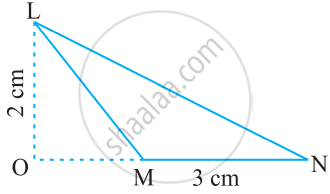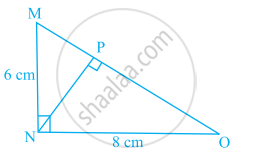Advertisements
Advertisements
प्रश्न
Find the area of the quadrilateral whose vertices, taken in order, are (-4, -2), (-3, -5), (3, -2) and (2, 3).
उत्तर

Let the vertices of the quadrilateral be A ( - 4, - 2), B ( - 3, - 5), C (3, - 2), and D (2, 3). Join AC to form two triangles ΔABC and ΔACD.
Area of a triangle =`1/2 {x_1 (y_2 - y_3) + x_2 (y_3 - y_1) + x_3 (y_1 - y_2)}`
Area of ΔABC = `1/2 [(-4) {(-5) - (-2)} + (-3) {(-2) - (-2)} + 3 {(-2) - (-5)}]`
= `1/2 (12+0+9)`
= 21/2 square units
Area of ΔACD = `1/2 [(-4) {(-2) - (3)} + 3{(3) - (-2)} + 2 {(-2) - (-2)}]`
= `1/2 (20+15+0)`
= 35/2 square units
Area of ☐ABCD = Area of ΔABC + Area of ΔACD
=`(21/2 + 35/2)` square units = 28 square units
संबंधित प्रश्न
For what value of x will the points (x, –1), (2, 1) and (4, 5) lie on a line ?
If the coordinates of two points A and B are (3, 4) and (5, – 2) respectively. Find the coordniates of any point P, if PA = PB and Area of ∆PAB = 10
In each of the following find the value of 'k', for which the points are collinear.
(8, 1), (k, -4), (2, -5)
Find values of k if area of triangle is 4 square units and vertices are (−2, 0), (0, 4), (0, k)
Find the missing value:
| Base | Height | Area of triangle |
| 15 cm | ______ | 87 cm2 |
Find the area of the quadrilaterals, the coordinates of whose vertices are
(−3, 2), (5, 4), (7, −6) and (−5, −4)
Show that the following sets of points are collinear.
(1, −1), (2, 1) and (4, 5)
Prove analytically that the line segment joining the middle points of two sides of a triangle is equal to half of the third side.
Find the area of the following triangle:

In the given figure, ΔMNO is a right-angled triangle. Its legs are 6 cm and 8 cm long. Length of perpendicular NP on the side MO is ______.

